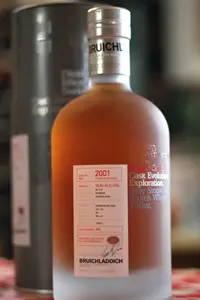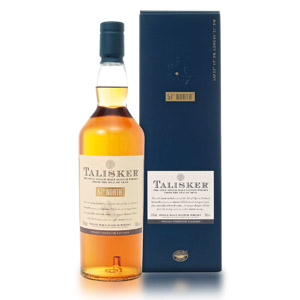 It’s easy to buy into the romance of Scotch production. The gleaming copper stills, the hardworking stillmen shoveling the barley and stoking the peat fire, and the amber liquid resting peacefully inside aromatic oaken casks, all images fostered by colorful labels and vivid magazine ads. It’s also easy to think of whisky as a timeless, unaging spirit, its flavors locked unchangeable, in perpetuity, inside its elegant glass bottle until the day we pop open the cork and explore its secrets.
It’s easy to buy into the romance of Scotch production. The gleaming copper stills, the hardworking stillmen shoveling the barley and stoking the peat fire, and the amber liquid resting peacefully inside aromatic oaken casks, all images fostered by colorful labels and vivid magazine ads. It’s also easy to think of whisky as a timeless, unaging spirit, its flavors locked unchangeable, in perpetuity, inside its elegant glass bottle until the day we pop open the cork and explore its secrets.
Sometimes, however, even the most carefully-made whisky goes awry. Recently, a shop-exclusive bottling of a cask-strength Bruichladdich chenin blanc finish, imported by a certain *cough* local store, dismayed its retailers and purchasers alike by turning sour… in the bottle. The spirit buyer had tasted the barrel sample when picking the cask and sampled it again several times when the beautifully-packaged bottles arrived. It wasn’t until the first pre-orders were filled and customers began drinking the contents did it become clear that the whisky was tainted somehow. It wasn’t just a few of them, either. Every last one was nigh undrinkable, including the bottle that the spirit buyer had already opened and which had tasted fine previously. Like a time bomb, set to explode after nine years of aging in ex-bourbon, seven months in ex-chenin blanc barrels, and six-odd months of bottling, packaging, shipping, and stocking, it just fell apart in the bottle.
As curious as I was when I heard about Loch Dhu, I had to experience this train wreck for myself. Luckily, I got a sample of the recalled spirit. Here’s a “tasting note”, although it won’t do anybody much good:
Nose: At first, there is freshly-squeezed lime, kiwi, and acidic fruit. Suddenly, a waft of acetone crawls up the nose. This is 59.8% ABV, after all, so I continue. The acetone becomes more and more gluey, becoming unmistakably like the rubber cement I remember from my elementary school days. Weird. Underneath the industrial sealant smell, there is a nice undercurrent of green grapes, honey, and unripe green plums.
Palate: What the…? The mouthfeel is gentle at first, with almost no sign of the 59.8% ABV punch I was prepared for. After several seconds, the alcohol burn appears, and grows, until my tongue is truly on fire. This is… *backwards*! Alongside the reversed alcohol burn, there is a great deal of acidic fruit, almonds, green grass, and a mouth-puckering dose of grape skin tannin. It actually makes my teeth itch.
Finish: Evolving again, the finish begins sweet, like muscat grapes, and then goes sour, with elements of white wine vinegar, glue, and grappa. The finish is actually quite short.
Overall: What a strange whisky. It almost does tricks, first inverting the natural order of things by growing more alcoholic on the tongue, then shifting flavor profiles (between sweet, sour, and industrial) several times on the finish. One can almost tell that this used to be a beautiful, fascinating whisky with clear French wine influences, until something went horribly, horribly wrong.
Check out a similar experience here: Scotch and Ice Cream, where poor unfortunate soul Tim paid for a bottle. (Hope you got your refund, Tim!). It should be noted that the fault for this lies somehow in nature, not with the retailer, nor with Bruichladdich. The retailer quickly recalled and exchanged all bottles from this cask with something else.
So what happened? The cork doesn’t smell rancid or mouldy (It just smells like the whisky). The bottles apparently all went sour at the same time, so it’s unlikely to be caused by individual mistakes in bottling or sealing. They were only bottled 7 months ago, so it’s unlikely that enough of it could have oxidized, even if every single bottle had a broken seal. The only likely explanation is that some chemical compound, formed by the very slow interaction of chenin blanc, oak, and Islay whisky and catalyzed either by the turbulence of shipping or the introduction of air into the freshly-opened bottles, transformed this beauty into a beast. Pity, that, but it goes to show that even something as frozen in time as bottled whisky is still a living thing with a spirit all its own.






Hah! Glad to see someone else talking about this. I’m genuinely curious what happened to this – it was really strange! I had a couple early pours that were really great – truly intense, richly nuanced, very complex stuff that I struggled to pick out all the notes because there was so much going on. When I gave a sample to Sku he absolutely panned it, which was a surprise. Then began the descent into madness – somewhere near the end, Driscoll’s email went out.
Needless to say it was completely bizarre. I agree that it seems weird for it to have oxidized so quickly, and the character it took was just so intensely weird and not moldy.
I’ll be very interested to hear what the word is from Bruichladdich as to what they think happened. Better still if Jim McEwan posts tasting notes on their youtube channel a la the recent notes for Comus, BA3 and Laddie 10.
-T
Tim, Indeed! I like to think of occurrences like this as a great opportunity to learn more about whisky – and what a “bad” whisky (or rather, a good whisky “gone” bad) tastes like. Learning more from one’s failures than one’s successes and all that. 🙂 A pity though, it must have cost our friends quite a chunk of change to make it right.
Wow, I heard about this yesterday at my local Whisky shop. this was the “Whisky of the week” and he allowed for tasting but he stated everyone that tasted (or bought it) came back and said they hated it. I will have to let him know about this situation, he still has about 4-5 bottles of it for sale!
Probably too late to comment but… I was finishing a dewars white label in a brandy cured micro cask, it was tasting speyside vanilla slightly sweet with a slow smooth finish, even my wife (not a whisky drinker) liked it; so I botteled it. Within three days it tasted like rubbing alcohol and I threw it out.